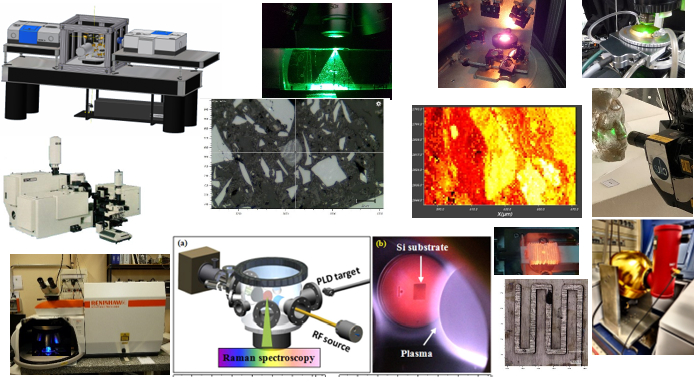The platform is composed of a unique set of tools, both original and efficient, which respond to the problems of studying the structure of materials under extreme conditions. The continuous evolution of the devices and the development of new tools allows to adapt to new scientific problems.

Facilities
spectral emittance measurement from 300 to 2500 K, from 10 to 20.000 cm-1 (from far IR to visible)
Hemispheric reflectance/transmittance measurements (vis. to MIR), specular and under microscope at 300 K over a wide range (from far IR to near IR)
Very high temperature Raman spectoscopy (3000K) (mm probe area) - time resolution (ns to ms lifetime studies)
Temperature micro-Raman (77 to 1800 K) (µm² resolution)
Fast Raman imaging, wide range of excitation wavelengths (µm² resolution)
Brillouin spectroscopy with microscope and heating stages (77 to 1800 K)
Complementarity of vibrational microscopy techniques (Brillouin, IR, Raman) (77 to 1800 K)
Combination of Brillouin interferometer and portable Raman spectrometer
Impedance spectroscopy in temperature, for solids and liquids, from 300 to 2000 K, under controlled atmosphere
Portable Raman (2 spectros and 7 probes) allowing various in situ studies (HT, irradiation, Earth sciences)
IR and Raman spectroscopies in temperature and pressure (autoclave, 1200°C, 2000 bar, Equipex PlaneX)
Fields of application
Effects of multi-scale structur of multiphase materials on their optical and thermo-radiative properties -> Material design, properties/applications optimization
Determination of the electrical conductivity of phases in heterogeneous media -> Geomaterials, glass ceramics, compacted powders
materials -> Glass, ceramics, glass-ceramics, biomaterials, nuclear materials, porous materials, geomaterials
relations between composition, microstructure and properties ->Study of the vibrational dynamics and optical indices (evolution in T)
Determination of the electrical conductivity of liquids at high temperatures under controlled atmosphere
Keywords
Optical properties, emissivity, vibrational spectroscopies, high temperature, irradiation, oxides, ceramics, glass-ceramics, carbon materials, nuclear materials, imagery/mapping
Training
Professional training: CNRS Entreprise training "Non contact temperature measurement" (A. Canizarès) Thematic schools: European school of Nuclear Surface, (A. Canizarès, 2018), Surface and nuclear school (P. Simon 2015, A. Canizarès 2022) Participation to the realization of the MOOC Spectroscopy (P. Simon, L. Del Campo, A. Canizarès)
Collaborations
Academics: regional, national (Orleans, Tours, Limoges, Nantes, Perpignan, Nantes ...) and international (China, Brazil, Russia, Thailand, Europe ...), CEA, Industrial; Saint Gobain, Celsian, Schott, SCQ Chemical. National networks: NEEDS. Research programs: Region, ANR, Europe - Research infrastructure: GDR: Tamarys, CMC2, SciNEE, Pilse.
La plateforme est composée d’un ensemble unique d’outils à la fois originaux et performants, qui répondent aux problématiques d’étude de la structure des matériaux en conditions extrêmes. L’évolution continue des dispositifs et le développement de nouveaux outils permet de s’adapter au mieux aux nouvelles problématiques scientifiques.

Equipements
Mesure de l’émittance spectrale de 300 à 2500 K, de 10 à 20.000 cm-1. (de l’IR lointain au visible)
Mesures réflectance/transmittance hémisphériques (vis. à MIR), spéculaires et sous microscope à 300 K sur une large gamme (de l’IR lointain à l’IR proche)
Spectroscopie Raman très haute température (3000K) (zone sondée mm) - résolution temporelle (étude des temps de vie de la ns à la ms)
Micro-Raman en température (77 à 1800 K) (résolution µm²)
Imagerie Raman rapide, large gamme de longueurs d’ondes d’excitation (µm²)
Interféromètre Brillouin avec microscope et platines chauffantes (77 à 1800 K)
Complémentarité des techniques de microscopies vibrationnelles (Brillouin, IR, Raman) (77 à 1800 K)
Couplage interféromètre Brillouin/spectromètre Raman portable opérationnel
Spectroscopie d’impédance en température, solide et liquide, 300 à 2000 K, sous atmosphère contrôlée
Dispositifs Raman portables (2 spectros et 7 sondes) permettant des études in situ variées (HT, irradiation, sciences de la Terre)
Spectroscopies IR et Raman en température et pression (autoclave, 1200°C, 2000 bar, Equipex PlaneX)
Domaines d’applications
Effets de la structuration multiéchelle de matériaux multiphasiques sur leurs propriétés optiques et thermo-radiatives -> Material design, optimisation des propriétés/applications
Détermination de la conductivité électrique des phases au sein de milieux hétérogènes -> Géomatériaux, vitrocéramiques, poudres compactées
Caractérisation des phases au sein des matériaux -> Verres, céramiques, vitrocéramiques, biomatériaux, matériaux nucléaires, matériaux poreux, géomatériaux
Relations entre composition, microstructure et propriétés ->Etude de la dynamique vibrationnelle et des indices optiques (évolution en t°)
Détermination de la conductivité électrique des liquides à hautes températures sous atmosphère contrôlée
Collaborations
Académiques : au niveau régional, national (Orléans, Tours, Limoges, Nantes, Perpignan, Nantes ...) et international (Chine, Brésil, Russie, Thaïlande, Europe ...), CEA, Industriels ; Saint Gobain, Celsian, Schott, SCQ Chemical. Réseaux nationaux : NEEDS. Programmes de Recherche : Région, ANR, Europe - Infrastructure de recherches : GDR : Tamarys, CMC2, SciNEE, Pilse.
Mots clefs
Propriétés optiques, émissivité, spectroscopies vibrationnelles, haute température, irradiation, oxydes, céramiques, vitrocéramiques, matériaux carbonés, matériaux du nucléaire, cartographie
Formations
Formation professionnelle : Formation CNRS Entreprise « Mesure de température sans contact » (A. Canizarès)
Ecoles thématiques : European school of Nuclear Surface, (A. Canizarès, 2018), Ecole surface et nucléaire (P. Simon 2015, A. Canizarès 2022)
Participation à la réalisation du MOOC Spectroscopie (P. Simon, L. Del Campo, A. Canizarès)
email : aurelien.canizares@cnrs-orleans.fr